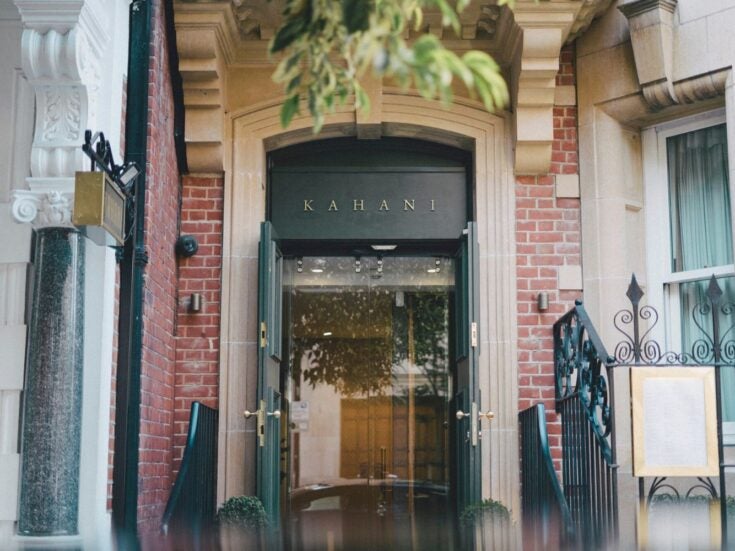
Chef D’oeuvre
Michelin-starred chef Pierre Gagnaire describes himself as an artist, but his reasoning’s a bit sketchy. Good thing his cooking’s picture-perfect, says Oliver Thring
WITH PIERRE GAGNAIRE, one senses, food is merely a conduit to higher things. ‘Jazz is a world music and is like cuisine in its multiform appearance reflecting the rhythms of life itself,’ he muses on his sprawling, largely impenetrable website. ‘The painter takes his own personal language,’ declaims the chef, ‘and uses that to express things which seemed inexpressible… The presentation of a dish teaches me new rules of harmony and through this exercise, I find a form of peace.’
He seems to prefer to see himself not as cook but as creator, an artist rather than a mere artisan. People with extensive experience of high-end restaurants often claim that the best — certainly the boldest — way to experience Gagnaire’s is to spurn the menu altogether, allowing the chef to ‘create’ according to his whims and fancy. This ‘can make the difference between an extraordinary experience and a disappointing one’, claims one well-known blogger.
The Observer restaurant critic Jay Rayner has written that Gagnaire off-menu is ‘a puff of nothing, bland and unmoving, a set of paintings with ingredients used only for their colour rather than their flavour’. But Gagnaire takes himself so seriously he even offers a protracted reading list, with publishers, the better for us to understand the man and his work.

Such self-importance can be rather off-putting, especially when the ‘creations’ don’t justify it — though in my experience of Gagnaire’s cooking they happily do. If the world of the superstar chef is at times an unpleasant one — endless plane journeys, meetings, interviews, handshakes, posing in kitchens, gurning for cameras — then Gagnaire suffers more than most. He has about a dozen restaurants around the world: in Courchevel, Paris, Moscow, Seoul, London, Hong Kong, Tokyo, and those famed gastronomic paradises, Dubai and Las Vegas. The fawning customers and, latterly, commercial success have provided Gagnaire with levels of self-belief remarkable even for a celebrity chef.
So when we meet at Sketch, the Mayfair venue he opened with Mourad Mazouz in 2002, I’m as keen to ask him about his ‘philosophy’ as his life and business. He was born in the Loire in 1950, the son of a chef and the eldest of four siblings. ‘I was a teenager when I realised I could cook,’ he says. ‘I saw then that I had a power on people.’
He chose not to work in his father’s restaurant, cooking elsewhere for a decade before returning to take it over in 1977. ‘I stayed there for five years but I wasn’t comfortable. With my brother and my sister,’ he pauses, ‘it was too complicated. I preferred to say, “Stop.” I left the system and I created my own restaurant in St Etienne.’
Michelin eventually awarded three stars to this venture, but the business folded in 1996, reportedly the first three-star in the history of the Guide Rouge to do so. Gagnaire blames this failure on the location, reasonably enough. And that, presumably, is why he has opened all his restaurants since then in areas populated by the international rich. His eponymous place in Paris soon gained three stars, and this distinction has been the basis for Gagnaire (like Alain Ducasse and Gordon Ramsay) to become a megastar chef with outposts around the globe.

Is there something a little soulless about opening a restaurant in, for example, Dubai — air-freighting the produce, catering to a room that could more or less be anywhere in the world? ‘The problem is never the produce,’ he says. ‘The spirit, the âme, is the guy who works. Many people say we’re the best in Dubai because we have a very good chef, good team, good partners. But creativity is important in this case because the only produce you have is camel meat.’
Illustration by Rebecca Buckland
CERTAINLY, THE MENU at Sketch is shorn of any ethnic or regional bias. A former Dior showroom, the townhouse combines two restaurants — the Michelin-starred Lecture Room, the funkier Gallery — and three other rooms which are cafés, bars or nightclubs depending on the time of day. Sketch remains controversial — when it opened it was famous for being the most expensive restaurant in Britain. ‘Mourad and I are not friends,’ says Gagnaire. ‘But we have no battle together. He is the fashion, the fête. Moi, it’s the quality, the food, the liquid. The music, the style is Mourad.’
If Sketch has a handicap, it may be this style. Outside the Lecture Room is a statue of a sitting woman with an afro made of real syringes. The whole project is arguably most famous for its loos: a whole floor is devoted to them, pink-lit, serried pods, hymned by sporadic flushes. They look like cryogenic capsules holding the frozen corpses of millionaires — which, come to think of it, may not be so far from the truth.
In Harden’s restaurant guides, voted for by the restaurant-going public, Sketch consistently achieves the lowest possible ratings for food and ambience. Richard Harden explains it thus: ‘Our readers place it in the bottom 8 per cent of restaurants for its price bracket around London. It has a niche with the fashion crowd, it’s aimed at the Wallpaper* magazine market.’ But Sketch has survived for almost a decade in perhaps the most competitive restaurant market on earth, so somebody else must be visiting it.
IN PART, THIS must be because the food in the Lecture Room is simply among the best in London. Flavours are headstrong, insistent, brash. Foie gras is paired with raw seafood. A salad of strawberries comes with thinly sliced radish, a combination so pretty and inspired it made you wonder why strawberries aren’t always served with radishes. A phalanx of puddings is dazzling, the crockery carefully matched to the dish. I’m no inspector, but the cooking easily surpasses several two-star meals I’ve had. Given this, what has held Sketch back from a second star? ‘It’s difficult to define because Sketch is not a real restaurant,’ says Gagnaire. ‘It’s a place where you have fun, music, perhaps too much of an experience. We open at 8am for breakfast and we close at 3am — it’s too complicated.’
But if the food is taken for granted, the ‘philosophy’ is not. What does he mean when he says that jazz influences his food? For the first time, Gagnaire looks unsettled. ‘Well…’ he says after some time. ‘Bon… It’s my life.’ He pauses. ‘It’s my pleasure.’ Another pause. ‘It’s difficult to explain. It’s like that: I love jazz and, bon, I love painting. And I try to live other cultures and others’ ways of thinking. And that translates on to my plate.’
A vague response, but that scarcely matters. Gagnaire’s iconoclastic position in international gastronomy is sure, whether or not his poncy pronouncements on the relationship between food and music make any sense. And, at least in one room in London, his cooking is astonishing.
Oliver Thring is a travel and food writer






